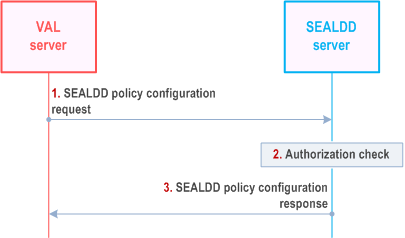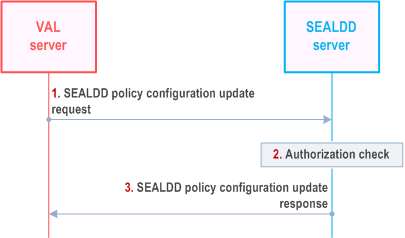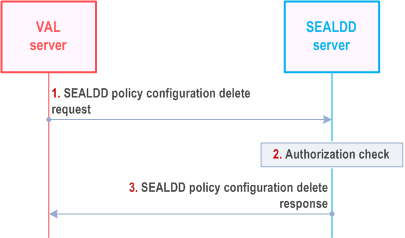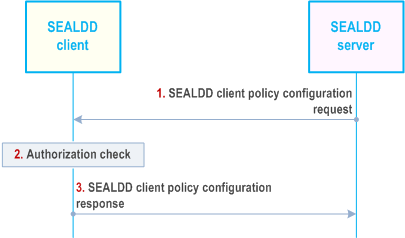Content for TS 23.433 Word version: 19.4.0
0…
4…
7…
8…
9.2…
9.2.2.3…
9.2.3…
9.2.4…
9.3…
9.3.2.2…
9.3.3…
9.3.4…
9.4…
9.5…
9.5.3…
9.5.4…
9.6…
9.7…
9.7.3…
9.7.4…
9.8…
9.9…
9.9.3…
9.10…
9.10.3…
9.11…
9.11.3…
9.12…
9.12.3…
9.13
10…
A…
C
D…
9.10 SEALDD policy configuration
9.10.1 General
9.10.2 Procedures
9.10.2.1 SEALDD policy configuration
9.10.2.2 SEALDD policy configuration update
9.10.2.3 SEALDD policy configuration delete
9.10.2.4 SEALDD client policy configuration request
...
...
9.10 SEALDD policy configuration p. 102
9.10.1 General p. 102
The following clauses specify procedures, information flow for SEALDD policy configuration. In clause 9.10, the VAL server is a specific server for configurating SEALDD policy, and is different from the VAL server used for VAL application processing in other clauses.
Depending on the configuration, a SEALDD policy may apply to individual SEALDD flows or to multi-modal SEALDD flows.
9.10.2 Procedures p. 102
9.10.2.1 SEALDD policy configuration p. 102
Figure 9.10.2.1-1 illustrates the procedure for SEALDD policy configuration from the VAL server used for SEALDD policy configuration to the SEALDD server.

Step 1.
The VAL server sends the SEALDD policy configuration request to the SEALDD server. The request includes the identifiers of the application traffic (e.g. VAL service ID, VAL server ID), VAL UE identify, and the SEALDD policy.
Step 2.
The SEALDD server performs authorization check to verify whether the VAL server can be accepted/authorized to configure the SEALDD policy.
Step 3.
Upon successful authorization, the SEALDD server stores the SEALDD policy for later use (e.g. for bandwidth control, transmission quality guarantee) and replies to the VAL server with the SEALDD policy configuration response.
9.10.2.2 SEALDD policy configuration update p. 102
Figure 9.10.2.2-1 illustrates the procedure for SEALDD policy configuration update from the VAL server used for SEALDD policy configuration to the SEALDD server.

Step 1.
The VAL server used for SEALDD policy configuration determines that the existing SEALDD policy needs to be updated, the VAL server sends the SEALDD policy configuration update request to the SEALDD server.
Step 2.
The SEALDD server performs authorization check to verify whether the VAL server can be accepted/authorized to update the SEALDD policy configuration.
Step 3.
Upon successful authorization, the SEALDD server updates the SEALDD policy configuration and replies to the VAL server with the SEALDD policy configuration update response.
9.10.2.3 SEALDD policy configuration delete p. 103
Figure 9.10.2.3-1 illustrates the procedure for SEALDD policy configuration delete from the VAL server used for SEALDD policy configuration to the SEALDD server.

Step 1.
The VAL server used for SEALDD policy configuration determines that the existing SEALDD policy needs to be deleted, the VAL server sends the SEALDD policy configuration delete request to the SEALDD server.
Step 2.
The SEALDD server performs authorization check to verify whether the VAL server can be accepted/authorized to delete the SEALDD policy configuration.
Step 3.
Upon successful authorization, the SEALDD server deletes the SEALDD policy configuration and replies to the VAL server with the SEALDD policy configuration update response.
9.10.2.4 SEALDD client policy configuration request |R19| p. 104
Figure 9.10.2.4-1 illustrates the procedure for SEALDD client policy configuration request from the SEALDD server to the SEALDD client.
Pre-condition:
- The SEALDD connectivity has been established between the SEALDD client and SEALDD server.

Step 1.
Based on policy received from the VAL server(e.g., Multi-modal flows alignment policy), or SEALDD server determines that the policy needs to be configured to the SEALDD client, the SEALDD server sends the SEALDD client policy configuration request to the SEALDD client.
Step 2.
The SEALDD client performs authorization check to verify whether the SEALDD server can be authorized to configure the SEALDD client policy.
Step 3.
Upon successful authorization, the SEALDD server stores the SEALDD client policy for later use (e.g. for multi-modal flows alignment) and replies to the SEALDD server with the SEALDD client policy configuration response.